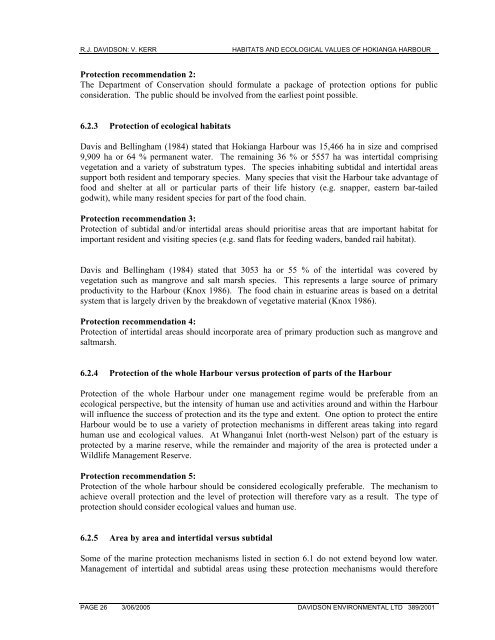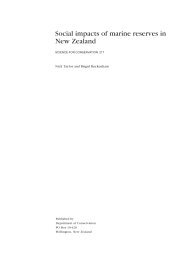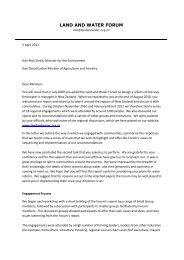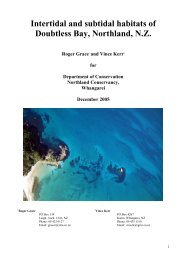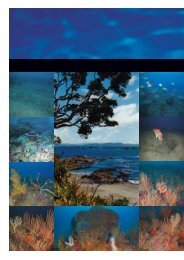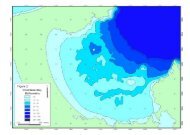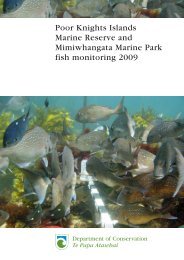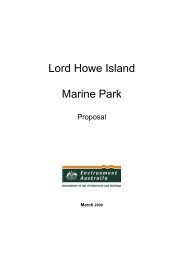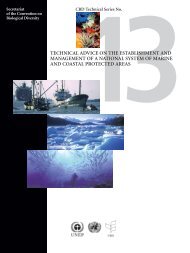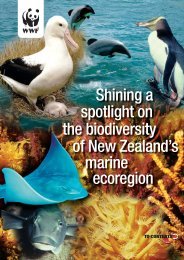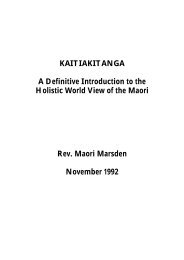Habitats and Ecological Values of the Hokianga ... - MarineNZ.org.nz
Habitats and Ecological Values of the Hokianga ... - MarineNZ.org.nz
Habitats and Ecological Values of the Hokianga ... - MarineNZ.org.nz
You also want an ePaper? Increase the reach of your titles
YUMPU automatically turns print PDFs into web optimized ePapers that Google loves.
R.J. DAVIDSON: V. KERR<br />
HABITATS AND ECOLOGICAL VALUES OF HOKIANGA HARBOUR<br />
Protection recommendation 2:<br />
The Department <strong>of</strong> Conservation should formulate a package <strong>of</strong> protection options for public<br />
consideration. The public should be involved from <strong>the</strong> earliest point possible.<br />
6.2.3 Protection <strong>of</strong> ecological habitats<br />
Davis <strong>and</strong> Bellingham (1984) stated that <strong>Hokianga</strong> Harbour was 15,466 ha in size <strong>and</strong> comprised<br />
9,909 ha or 64 % permanent water. The remaining 36 % or 5557 ha was intertidal comprising<br />
vegetation <strong>and</strong> a variety <strong>of</strong> substratum types. The species inhabiting subtidal <strong>and</strong> intertidal areas<br />
support both resident <strong>and</strong> temporary species. Many species that visit <strong>the</strong> Harbour take advantage <strong>of</strong><br />
food <strong>and</strong> shelter at all or particular parts <strong>of</strong> <strong>the</strong>ir life history (e.g. snapper, eastern bar-tailed<br />
godwit), while many resident species for part <strong>of</strong> <strong>the</strong> food chain.<br />
Protection recommendation 3:<br />
Protection <strong>of</strong> subtidal <strong>and</strong>/or intertidal areas should prioritise areas that are important habitat for<br />
important resident <strong>and</strong> visiting species (e.g. s<strong>and</strong> flats for feeding waders, b<strong>and</strong>ed rail habitat).<br />
Davis <strong>and</strong> Bellingham (1984) stated that 3053 ha or 55 % <strong>of</strong> <strong>the</strong> intertidal was covered by<br />
vegetation such as mangrove <strong>and</strong> salt marsh species. This represents a large source <strong>of</strong> primary<br />
productivity to <strong>the</strong> Harbour (Knox 1986). The food chain in estuarine areas is based on a detrital<br />
system that is largely driven by <strong>the</strong> breakdown <strong>of</strong> vegetative material (Knox 1986).<br />
Protection recommendation 4:<br />
Protection <strong>of</strong> intertidal areas should incorporate area <strong>of</strong> primary production such as mangrove <strong>and</strong><br />
saltmarsh.<br />
6.2.4 Protection <strong>of</strong> <strong>the</strong> whole Harbour versus protection <strong>of</strong> parts <strong>of</strong> <strong>the</strong> Harbour<br />
Protection <strong>of</strong> <strong>the</strong> whole Harbour under one management regime would be preferable from an<br />
ecological perspective, but <strong>the</strong> intensity <strong>of</strong> human use <strong>and</strong> activities around <strong>and</strong> within <strong>the</strong> Harbour<br />
will influence <strong>the</strong> success <strong>of</strong> protection <strong>and</strong> its <strong>the</strong> type <strong>and</strong> extent. One option to protect <strong>the</strong> entire<br />
Harbour would be to use a variety <strong>of</strong> protection mechanisms in different areas taking into regard<br />
human use <strong>and</strong> ecological values. At Whanganui Inlet (north-west Nelson) part <strong>of</strong> <strong>the</strong> estuary is<br />
protected by a marine reserve, while <strong>the</strong> remainder <strong>and</strong> majority <strong>of</strong> <strong>the</strong> area is protected under a<br />
Wildlife Management Reserve.<br />
Protection recommendation 5:<br />
Protection <strong>of</strong> <strong>the</strong> whole harbour should be considered ecologically preferable. The mechanism to<br />
achieve overall protection <strong>and</strong> <strong>the</strong> level <strong>of</strong> protection will <strong>the</strong>refore vary as a result. The type <strong>of</strong><br />
protection should consider ecological values <strong>and</strong> human use.<br />
6.2.5 Area by area <strong>and</strong> intertidal versus subtidal<br />
Some <strong>of</strong> <strong>the</strong> marine protection mechanisms listed in section 6.1 do not extend beyond low water.<br />
Management <strong>of</strong> intertidal <strong>and</strong> subtidal areas using <strong>the</strong>se protection mechanisms would <strong>the</strong>refore<br />
PAGE 26 3/06/2005 DAVIDSON ENVIRONMENTAL LTD 389/2001


